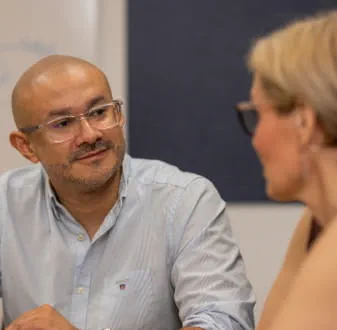According to the KPMG 2021 Project Management Report (Australia), a full 68% of organisations surveyed have now adopted Agile project management methodologies.
However, Agile project management is not just for developing products and improving business: it can also be an important tool to deliver improved social impact results.
Agile project management (one of the non-traditional methods) has the potential to deliver flexible outcomes and better results at a lower cost, which is exactly the kind of boost that non-profits, social enterprises and other social impact organisations typically need. However, that’s just the tip of the iceberg.
Here’s how it works.
What is an Agile project management methodology?
Agile has many flavours and is a unique approach to management that was originally invented in the late nineties by software developers as a way to improve and speed up the rollout of new software products.
Amongst the flavours of Agile there are several options, including Scrum, Kanban, ScrumBan, Crystal, AUP, DSDM, FDD, XP, Lean and Hybrid, not to mention Scaled Agile, Disciplined Agile, Large Scale Scrum and Enterprise Kanban.
Over the past few decades, it’s grown massively in popularity and scope, with managers now applying this approach across a range of different areas in projects and business operations.
Put simply, the Agile approach is an iterative approach to project management, where:
- A large project is broken down into a series of small 1-4 week stages, called sprints
- Each stage involves total collaboration across a team with daily meetups or “scrums”
- Work is transparent and shared in real time through use of tools, like Scrum and Kanban boards (if Kanban is adopted)
- Consumer feedback loops are included in every sprint
- The analysis, design, building or implementation and review phases are all conducted within each sprint
- Each stage in the life cycle leads to one complete iteration of a product or outcome
In contrast, traditional forms of project management, such as the waterfall approach, spend more time with upfront planning and divide a whole project into a few typical, major stages; research and analysis, design, construction and feedback. Completion of this process takes up the entire project life cycle, and consumer feedback only comes in at the end of the process.
However, Agile is more than just a management methodology; it’s also a philosophy to improve organisational agility and a particular way of thinking about collaboration, workflow and the creative process. At its core, it’s about adaptability to change and prioritisation of people. The original 2001 Agile Manifesto calls for placing value on:
- Individuals and interactions over processes and tools
- Working software over comprehensive documentation (or products)
- Customer collaboration over contract negotiation
- Responding to change over following a plan
At its heart, the Agile approach is about exactly what its name suggests: being agile. By replacing a rigid process with a creative, collaborative approach that prioritises people and is flexible to change, Agile allows managers and project managers to deliver outcomes quickly and effectively, in an unpredictable world.
Benefits of Agile project management
The success of Agile in delivering outcomes in tech and business over the past few decades has attracted recognition from universities, consultancies and journals, such as Harvard Business Review.
In one study of projects using Agile versus waterfall approaches over a five year period, consulting firm Standish Group found that on average, Agile projects enjoy a 60% greater chance of success than non-agile projects. Overall, they were also 1/3 less likely to fail as waterfall projects.
Another study by McKinsey shows that enterprise-wide agile transformations have improved customer satisfaction, employee engagement and operational performance.
Fundamentally, Agile project management allows an organisation to save on time and costs by releasing segments for review before it’s completed, thereby involving the end user or client in the design process. This ensures continual adaptation and flexibility, ensuring that the final output matches the users or clients’ needs.
A traditional waterfall process, on the other hand, only allows for feedback at the end of the life cycle, when it becomes time consuming and costly to correct them.
Specifically, an Agile approach to project management has been shown to result in a wide variety of benefits:
- The talent of all teams are utilised at once
- Workflow is transparent with the use of Scrums and Kanban boards
- Increased focus on the specific needs of end users
- Better control of projects
- Team members feel ownership and empowered to deliver better outcomes
- Reduced waste through minimising resources
- Increased flexibility enabling teams to easily adapt to change
- Faster detection of issues or defects
- Faster project turnaround times
- Increased frequency of collaboration and feedback
- Improved development process
- Increased chance of output success because efforts are more focused
- Rapid identification of problems and deployment of solutions
How Agile Project Management can be applied within social enterprises and non-profits
Just like businesses, social enterprises, non-profits and other social impact organisations also need flexible, responsive and effective ways of managing projects in today’s economy.
Because of the extraordinary time and financial constraints, as well as the pressure to deliver fast social outcomes that many social impact organisations experience, the case has been made that these types of operators have an even greater need for an Agile approach.
In fact, social businesses and non-profits are already required to be innovative and flexible, and in this sense are already well suited to the Agile approach.
There are a huge range of potential benefits for social enterprises, non-profits and social impact organisations in taking up Agile. Virtually any function where there is room for improvement could be workshopped for solutions via an Agile project. It can be applied to practically any of the major outputs that every non-profit or social enterprise must regularly deliver.
For example, the Agile project methodology can be used to:
- Improve fundraising activities.
- Deliver better health, humanitarian or outreach services to users.
- Build an innovative business model.
- Implement more effective corporate social responsibility
- Develop more effective forms of reporting and accountability for donors.
- Meet client needs more effectively at lower cost.
- Streamline more efficient use of donor resources
- Develop an innovative marketing strategy that effectively reaches an audience
- Build a website and multi-platform social media presence
- Implementing an Agile change management process within the organisation
- Empower employees and encourage innovation
- Improve the management of volunteers
- Increase the level of collaboration
Instead of using the sprint and scrum practises to test out consumer response to a product, a non-profit or social enterprise can use Agile to get feedback from the community they serve, ensuring they are meeting people’s needs.
There are a growing number of non-profits and social enterprises that have already begun to utilise various Agile approaches across different areas.
Forbes has reported the use of Agile by non-profits and social enterprises, such as Open To Hope, Goodwill Industries, Hunger Relief International, Saving Moses and FINCA International. Other organisations reporting the use of Agile project management include the Vermont Arts Council and non-profits New Boco and Data Arts.
Although there is no broad study of use of Agile project management among non-traditional organisations to draw from, reported feedback from these organisations about their implementation of Agile has overall been positive.
Gloria Horsley of Open to Hope, for example, told Forbes, “The ability to make changes on the fly because of using agile processes and structures has been one of the greatest benefits. Certain fundraising campaigns were tweaked even after they were released, which would have never previously happened. For that, we received a much greater response and financial results.”
Of course, Agile project management does not have to be introduced as a huge, whole organisation overhaul. Many non-profits and social enterprises are finding it useful to use just some aspects of agile, such as sprints, Kanban boards or are applying parts Agile in a Hybrid approach to just some projects or parts of operations.
However, Agile is not the solution for all projects and careful consideration is required on the culture (trust, buying, decision making), team (size, experience level, access to customer) and project (likelihood of changes, criticality, level of strategic importance and appetite for risk).
Whatever the size or mission of your organisation, there are many flexible ways you can apply Agile project management depending on your needs to support the delivery of outcomes.





